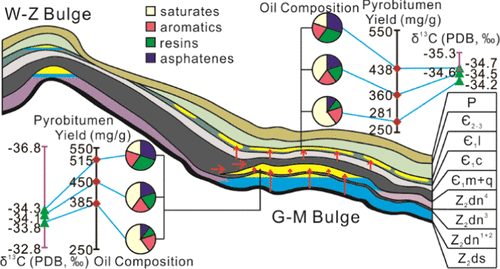当前位置:
X-MOL 学术
›
Energy Fuels
›
论文详情
Our official English website, www.x-mol.net, welcomes your feedback! (Note: you will need to create a separate account there.)
Origin and Formation of Pyrobitumen in Sinian–Cambrian Reservoirs of the Anyue Gas Field in the Sichuan Basin: Implications from Pyrolysis Experiments of Different Oil Fractions
Energy & Fuels ( IF 5.3 ) Pub Date : 2020-12-29 , DOI: 10.1021/acs.energyfuels.0c03263 Xing Wang 1, 2 , Hui Tian 1 , Qin Zhou 1 , Chunmin He 1, 2
Energy & Fuels ( IF 5.3 ) Pub Date : 2020-12-29 , DOI: 10.1021/acs.energyfuels.0c03263 Xing Wang 1, 2 , Hui Tian 1 , Qin Zhou 1 , Chunmin He 1, 2
Affiliation

|
Plenty of pyrobitumens were found throughout the Sinian Dengying and Cambrian Longwangmiao reservoirs of the Anyue gas field in the central Sichuan Basin. However, their genetic sources and formation processes still remain less constrained due to their strong heterogeneity in carbon isotopes and contents. In this study, an oil sample collected from the Devonian bituminous sandstones in the northwestern Sichuan Basin, along with its four fractions (i.e., saturates, aromatics, resins, asphaltenes (SARA)), was pyrolyzed in sealed gold tubes to investigate the generation and evolution process of pyrobitumen. Experimental results show that the four fractions generate pyrobitumen at different thermal maturity stages during oil cracking and the pyrobitumen yields of different oil fractions follow the following order: asphaltenes > resins > aromatics > saturates. For the pyrobitumen generated from the same oil fraction, the stable carbon isotopes of pyrobitumen become only slightly heavier with increasing maturation. At the same level of thermal maturity, pyrobitumen from saturates is more enriched in 13C than those from the other three oil fractions, and the maximum difference is over 2‰. Based on the experimental results, kinetic parameters for pyrobitumen generation from the four oil fractions were determined and then applied to investigate the origin and formation time of pyrobitumen in the Sinian Dengying and the Cambrian Longwangmiao reservoirs. The results show that the pyrobitumen in both the Sinian and the Cambrian reservoirs were mainly formed during the middle Jurassic to early Cretaceous. Although the pyrobitumen yields are significantly dependent on the SARA composition of oils, the change in pyrobitumen carbon isotopes is usually less than 1‰. This indicates that the carbon isotopes of pyrobitumen are mainly controlled by the initial carbon isotopes of SARA fractions that are closely related to their source rocks. Based on the carbon isotopes of pyrobitumen and potential source rocks, the precursor oils of pyrobitumen in the Cambrian Longwangmiao reservoirs are mainly derived from the Lower Cambrian Qiongzhusi source rock, while the precursor oils of pyrobitumen in the Sinian Dengying reservoirs are mixed oils sourced from both the Sinian and the Lower Cambrian source rocks.
中文翻译:

四川盆地安岳气田震旦—寒武系储层热解岩的成因与形成-来自不同馏分热解实验的启示
在四川盆地中部安岳气田震旦系灯影和寒武纪龙王庙储层中发现了大量的火山岩。但是,由于它们在碳同位素和含量上的强烈异质性,它们的遗传来源和形成过程仍然受到较少的限制。在这项研究中,从密封的金管中热解了从四川盆地西北部泥盆纪沥青砂岩中收集的石油样品及其四个馏分(即饱和油,芳烃,树脂,沥青质(SARA)),以研究其生成和成因。焦油门的演化过程。实验结果表明,在石油裂解过程中,这四个馏分在不同的热成熟阶段均生成焦油双酚,不同油馏分的油烟双酚的产率遵循以下顺序:沥青质>树脂> 芳烃>饱和。对于由相同的油馏分产生的焦油烟火石,随着成熟度的增加,焦油烟火石的稳定碳同位素变得仅略微重些。在相同的热成熟水平下,来自饱和物的焦磷酸酶在13C比其他三个油馏分的C高,并且最大差超过2‰。根据实验结果,确定了由这四个油馏分产生的火成岩动力学参数,然后用于调查震旦系灯影和寒武纪龙王庙油藏的火成岩成因和形成时间。结果表明,震旦纪和寒武纪储层的火山岩形成主要在侏罗纪中期至白垩纪早期。尽管焦炉子的产率显着取决于油的SARA组成,但是焦炉子碳同位素的变化通常小于1‰。这表明,火山岩的碳同位素主要受与其源岩密切相关的SARA组分的初始碳同位素控制。
更新日期:2021-01-21
中文翻译:

四川盆地安岳气田震旦—寒武系储层热解岩的成因与形成-来自不同馏分热解实验的启示
在四川盆地中部安岳气田震旦系灯影和寒武纪龙王庙储层中发现了大量的火山岩。但是,由于它们在碳同位素和含量上的强烈异质性,它们的遗传来源和形成过程仍然受到较少的限制。在这项研究中,从密封的金管中热解了从四川盆地西北部泥盆纪沥青砂岩中收集的石油样品及其四个馏分(即饱和油,芳烃,树脂,沥青质(SARA)),以研究其生成和成因。焦油门的演化过程。实验结果表明,在石油裂解过程中,这四个馏分在不同的热成熟阶段均生成焦油双酚,不同油馏分的油烟双酚的产率遵循以下顺序:沥青质>树脂> 芳烃>饱和。对于由相同的油馏分产生的焦油烟火石,随着成熟度的增加,焦油烟火石的稳定碳同位素变得仅略微重些。在相同的热成熟水平下,来自饱和物的焦磷酸酶在13C比其他三个油馏分的C高,并且最大差超过2‰。根据实验结果,确定了由这四个油馏分产生的火成岩动力学参数,然后用于调查震旦系灯影和寒武纪龙王庙油藏的火成岩成因和形成时间。结果表明,震旦纪和寒武纪储层的火山岩形成主要在侏罗纪中期至白垩纪早期。尽管焦炉子的产率显着取决于油的SARA组成,但是焦炉子碳同位素的变化通常小于1‰。这表明,火山岩的碳同位素主要受与其源岩密切相关的SARA组分的初始碳同位素控制。


























 京公网安备 11010802027423号
京公网安备 11010802027423号